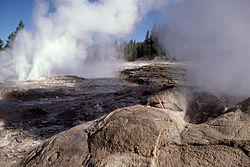- Fan and Mortar Geysers
-
Fan and Mortar Geysers 
Mortar in the foreground, and Fan in the backgroundName origin Fan - Washburn Party (1870)
Mortar - Frank Jay Haynes (1883)Coordinates 44°28′28″N 110°50′33″W / 44.47444°N 110.8425°WCoordinates: 44°28′28″N 110°50′33″W / 44.47444°N 110.8425°W Elevation 7,300 feet (2,200 m)[1] Temperature 48.2 °C (118.8 °F)[2] Fan and Mortar Geysers are two geysers in the Upper Geyser Basin in Yellowstone National Park. These two geysers, for the past several decades, have always erupted in concert with one another and are generally talked about together. The records detailing these geysers' known eruptive history shows that they have been infrequent and irregular performers.
Contents
History
Fan and Mortar's effect on the surrounding area, plus the size of their respective cones reveal that they were very active in the past. However, up until 1925, they were essentially two geysers that were very close to each other as their eruptive patterns were both independent of each other and were nowhere near the power of the eruptions of today. Some time preceding 1925, the two must have been eventually become connected at some depth and they have since performed as one very large geyser[3]. Fan Geyser was name by the Washburn–Langford–Doane Expedition of 1870[4]. Mortar Geyser was named by Frank Jay Haynes in 1883 because eruptions resembled mortar discharges[4].
Location
The two geysers lie right of the edge of the Firehole River. Fan and Mortar Geysers are easily viewed from both the bridge and the sidewalk directly leading north to Morning Glory Pool. This area is just a bit north from Riverside Geyser.
Description
The two geysers lay on the edge of the Firehole River, just like Riverside Geyser. However, both of the geysers are on the same side of the river as the viewing area, unlike Riverside. Mortar consists of the large mortar-looking cone on the left. It consists of the vent in the cone, known as Upper Mortar, the vent right below it, known as Lower Mortar, as well as an additional smaller vent to the left of Lower Mortar. Fan consists of at least 7 vents aligned roughly perpendicular to the river. They are known as (starting closest to the river), River Vent(s), High Vent, Gold Vent, Gold 2, Angle Vent, Main Vent, and the East Vent. A numerous assortment of other vents are scattered through the area, as well as one other geyser, close to the boardwalk, known as Spiteful Geyser.
Eruptive pattern
The geysers follow a series of cycles prior to erupting. They are:
- A pause in which neither geyser is splashing,
- Surging in Mortar's lower vent,
- Jetting in three of Fan's vents, generally the river vents and the main vent.
- A return toward Mortar and another pause.[3]
Generally the geysers are known to erupt during stage three, when Fan is currently splashing, although there have been eruptions that begin with Lower Mortar, and ever rarer: Upper Mortar. Preceding an eruption, the water levels in the whole complex will generally rise, but be wary. The geysers may erupt at any time. The geyser's eruption will become more powerful, and the water level in the complex will rise. Splashing in the river and main vents will increase, and there may be a massive surge from the east vent triggering the eruption. All the vents in Fan will constantly jet water, with the angle vent launching water up to the boardwalk, and sometimes beyond it. Fan will show why its name is so deserved, as it erupts out of 7 different vents, creating a wide fan-shaped jet that reaches heights of over 100 feet, and arcs water up over the boardwalk, landing 200 feet away from the vent. Mortar, while not as spectacular as Fan, sends jets out of its two main vents up to 50 feet high. Sometimes one vent will dominate the eruption sending a plume of water over 80 feet into the air. The eruption will generally last for around 15 minutes, until it stops, then restarts again, this time fading in power. It does this a few more times, until about 45 minutes have elapsed. It may then enter into a slight steam phase, where the geysers will send out brief puffs of steam out of their vents.
Notes
- ^ U.S. Geological Survey Geographic Names Information System: Fan Geyser
- ^ "Fan Geyser". Yellowstone Geothermal Features Database. Montana State University. 1999-06-19. http://www.rcn.montana.edu/resources/features/feature.aspx?nav=11&id=UMGG004. Retrieved 2009-12-19.
- ^ a b Scott, Bryan, T. (2001). The Geysers of Yellowstone. Niwot, Co: University Press of Colorado. pp. 119–121.
- ^ a b Bauer, Clyde Max (1947). Yellowstone Geysers. Yellowstone Park, Wyoming: Haynes. pp. 99,107. ASIN B0007E44C4.
Geothermal features and other attractions in the Upper Geyser BasinGeysers Anemone Geyser • Artemisia Geyser • Atomizer Geyser • Aurum Geyser • Baby Daisy Geyser • Beehive Geyser • Big Cub Geyser • Bijou Geyser • Bulger Geyser • Castle Geyser • Comet Geyser • Daisy Geyser • Economic Geyser Crater • Fan and Mortar Geysers • Giant Geyser • Giantess Geyser • Grand Geyser • Grotto Geyser • Jewel Geyser • Lion Geyser • Old Faithful Geyser • Penta Geyser • Pump Geyser • Riverside Geyser • Sawmill Geyser • Solitary Geyser • Spasmodic Geyser • Splendid Geyser • Turban Geyser • Vent Geyser • West Triplet Geyser
Hot Springs Beauty Pool • Belgian Pool • Brilliant Pool • Crested Pool • Chromatic Spring • Doublet Pool • Morning Glory PoolLone Star Geyser Basin Lone Star GeyserStructures and History Geography List of Yellowstone National Park related articles
 Media related to Upper Geyser Basin at Wikimedia Commons
Media related to Upper Geyser Basin at Wikimedia Commons State of Wyoming
State of WyomingTopics - Governors
- Delegations
- Geography
- Government
- History
- People
- Visitor Attractions
- State Symbols
- Radio Stations
Society - Crime
- Demographics
- Economy
- Education
- Politics
Regions Cities Counties Categories:- Yellowstone geothermal features
- Geothermal features of Teton County, Wyoming
Wikimedia Foundation. 2010.
